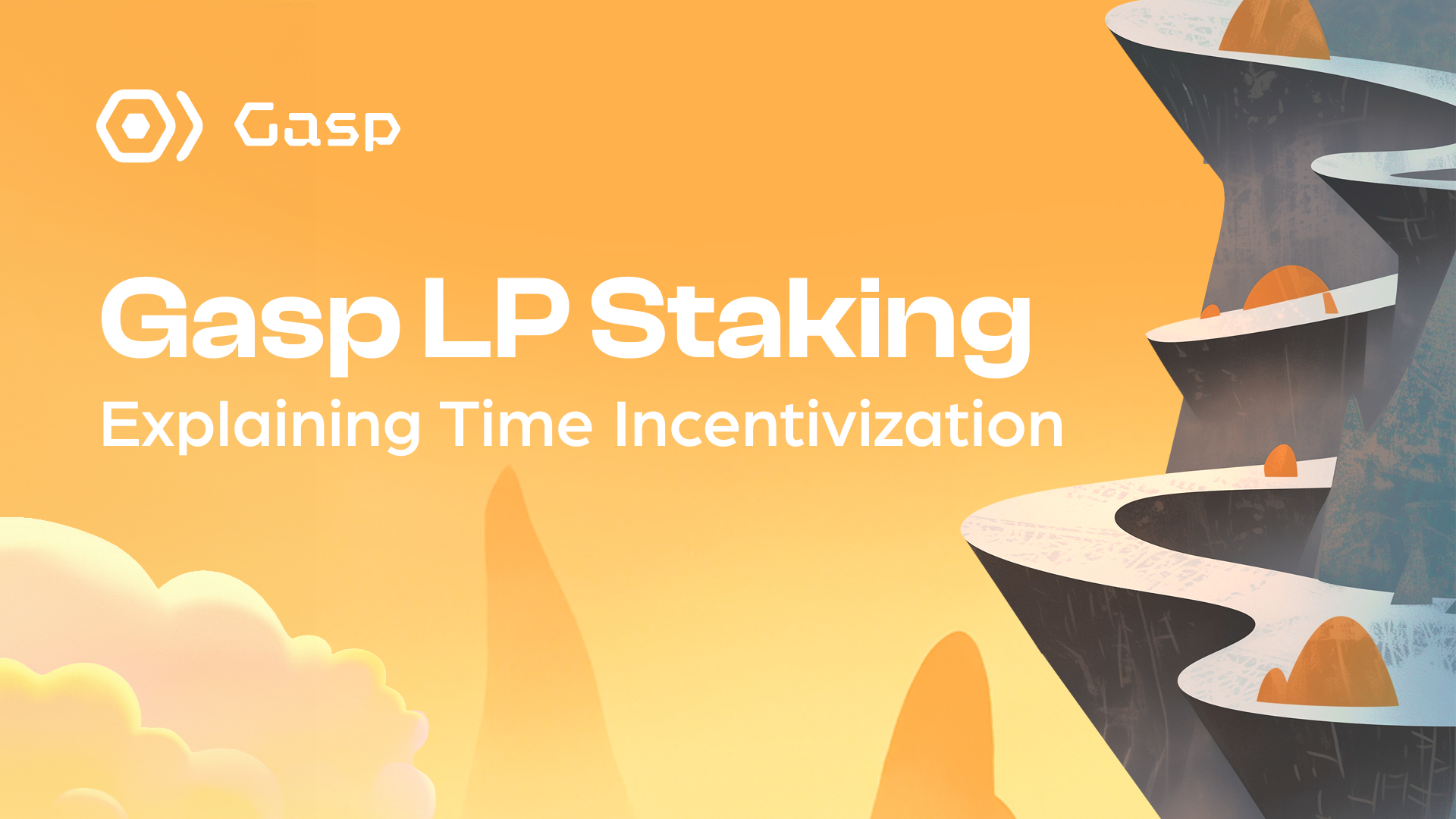Gasp LP Staking - Explaining Time Incentivization

Gasp Liquidity Mining Series
We’re fast approaching the Gasp mainnet launch, and that means that features such as staking and liquidity provision on our mainnet are close to going live. In the Gasp ecosystem, unlike other DeFi protocols and DEX’s, our loyalty reward mechanism for liquidity providers (LPs) incentivizes the time spent on liquidity provision, increasing rewards for capital that has spent a longer period of time working in a pool.
We call this ‘time incentivization’, and it’s a core concept of how we introduce fairness and stability to Gasp behind the scenes. But why have we introduced this concept?
This article examines the definition of and issues arising from ‘mercenary capital’, and introduces time incentivized liquidity mining - Gasp’s novel solution to attract calm liquidity for predictable markets.
An Army of Mercenaries is Unreliable
Mercenary capital refers to liquidity that is quick to move in and out of DeFi protocols in pursuit of the highest yields. This type of capital is often driven by speculative motives rather than a commitment to support the ecosystem over the long term. It is attracted by high incentives such as liquidity mining rewards or yield farming opportunities but will quickly exit when more lucrative opportunities arise elsewhere. To better understand mercenary capital, imagine an army of mercenaries. Mercenaries are soldiers for hire, fighting not out of loyalty or allegiance but for monetary gain. Their commitment lasts only as long as the rewards are substantial, making them unreliable and unpredictable allies.
Similarly, mercenary capital is fluid and transient, with LPs deploying their assets wherever they see the highest returns. This behavior can lead to rapid shifts in liquidity, causing volatility and instability in DeFi protocols. Just as a mercenary army might abandon their post if a better offer comes along, mercenary capital can withdraw liquidity en masse, leaving liquidity pools depleted and markets vulnerable.
On the other hand, DEX’s must attract liquidity miners to their protocol in order to provide sufficient buy and sell side liquidity for trading pairs. To do this, DEX’s attract liquidity with mining incentives. This is a common element of any DEX and forms the fundamental basis of decentralized exchange in web3.
But because of the mechanisms described above, issues arise as liquidity washes from pool to pool every few days. Pools are dominated by liquidity providers that select for the highest APR, without much respect for the turbulence they cause in pools they are leaving.
This creates a lot of unpredictability and movement, making the situation for everyone else very uncertain. Will the liquidity stick, or will it leave the DEX altogether after a few weeks when the next hottest platform opens up? In practical terms, there are few incentives to stop liquidity leaving a pool as miners seek higher returns elsewhere. This is where Gasp’s Time Incentivized Liquidity Mining comes in.
Design Goals for Time Incentivized Liquidity Mining
When we think about the ideal DEX, we imagine a DEX that steadily builds up liquidity on important pools. The DEX has the right incentives put in place to attract calm and predictable liquidity that allows users to gain trust and create an upward momentum for everyone; enabling users to safely enter and depart with their assets without unnecessary volatility.
A DEX has to go with the flow of the market, but at the same time it can slow down the negative effects of the market by clever design. This is the starting point for time incentivized liquidity mining - rewarding the time that capital has worked in a liquidity pool
The primary design goal is to set up liquidity mining rewards in a way that rewards loyal liquidity providers that stay longer in a liquidity pool. The liquidity should be “calmer”. At Gasp, we want to attract liquidity providers who are more thoughtful about where they want to stay and that is loyal to the protocol; and reward the amount of time that capital has spent working in a pool. The longer the capital has ‘worked’, the more rewards it will get.
At the same time, we need to consider the fluctuations in the market. LPs should not fear that time incentivization requires an undesirable lock-in or has too big opportunity costs. Gasp will not force LP’s to deposit into long-term locked vaults or lock their capital away in other ways! Instead, we want to provide an attractive offer while maintaining the freedom of users to move their capital at any point.
Likewise, potential liquidity providers should not feel like they cannot catch up with the rewards that older LPs get. There should not be a situation where there are “incentive whales” that grab all the rewards from the platform. We need to find a solid middle ground of incentivizing time and inviting new players.
Approaches
It is easier to show our time incentive solution by discussing different approaches that are utilized throughout the ecosystem. From simple to more complex approaches, this section explains Gasp’s model and the process of how & why we came up with the idea.
The linear approach
The basic solution is to ramp up reward emissions over time: Give out more rewards for liquidity that has been staying in the pool for a longer amount of time. This makes it attractive to remain loyal to the pool and should incentivize providers to consider it very thoroughly before leaving the pool and giving up the accumulated progress. It also disincentivizes short-term liquidity provision, as the rewards only start to stack up later.
This approach can lead to two major problems: Either the rewards start so slow that they almost don’t provide anything in the beginning (carrying huge opportunity costs) or they get large very fast and lead to hyperinflation of the protocol token.
A second major issue is that it keeps scaling infinitely, creating incentive whales that take most of the incentives, and leaving almost nothing for new liquidity providers. In this situation, the pool might even slowly die off because no new liquidity providers would be incentivized to join the pool.
The ‘linear with limit’ approach
Let’s introduce a new rule and say that the rewards will hit a limit after some time.
This approach keeps the advantages of disincentivizing provision for only a few days and increases rewards over time. This approach is fairer to new users since they have a chance to catch up after some time.
At the same time, there remain some disadvantages. One major concern with this approach is that the ramp-up time carries a lot of opportunity costs in which the rewards are only at a fraction of their eventual level.
We need a quicker on-ramp! This leads us to a refined approach.
Gasp’s Approach: Asymptotic Reward Curve
We are introducing an asymptotic reward curve for time incentivized liquidity mining.
This curve offers a quick on-ramp and continually increases the rewards of senior users relative to newcomers while giving new users a chance to catch up significantly in the first few weeks. The reason is that the growth of additional rewards per time slows down as it approaches its full capacity.
Gasp asymptotic reward curve is configured to reach >90% utilization within 8 weeks, allowing users to onboard quickly. While disincentivizing the short-term provision, the curve rewards loyalty since it infinitely increases.
Scenarios
Let’s put these in practical examples to provide a better understanding of what these mean for the liquidity providers and explain the effects of how the Gasp approach plays out further.
Later user joins
This chart compares two users. The first user joins the pool on day zero and the second one joins after a month. Let’s assume they are providing the same amount of liquidity, hence they have the same curve. But since the second user joins the pool later, the second user will always be behind the first user. But the difference shrinks over time.
Adding liquidity
In this example, the user adds the same amount of liquidity on top of its initially provided liquidity after a month. Since adding liquidity after some time will create a different maximum on the curve, this design prevents a user to ramp up its percentage with a small amount of capital and farm the increased incentives by adding great sums of liquidity afterward.
Building a Reliable LP Army
Traders and liquidity providers require stability and predictability instead of unstable pools with high slippage and mercenary capital. To provide balance, Gasp incentivizes those users who stick with the protocol in order to create stable pools and reward our early supporters for their loyalty.
Time Incentivization rewards long-term liquidity providers by establishing a fair ground for them against incentive whales that abuse high APR pools and leave after the incentives dry up.
To learn more about time incentivization in the Gasp ecosystem, check out our documentation here.

